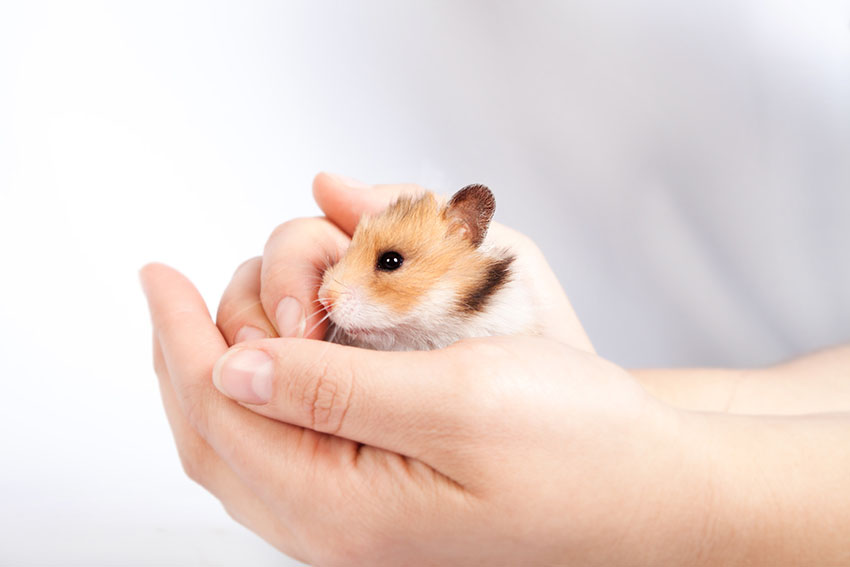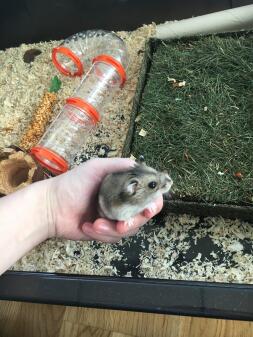Don’t worry if you’ve never held a hamster before. It’s easy, and it’s fun. Once the hamster has gotten to know you, he’ll be happy to sit in your hands, and will soon get used to being regularly handled.
Always supervise any young children that want to handle the new pet. The checklist below will help you get it right first time.

Once hand-tamed, hamsters love interacting with you
- Let’s begin with the thing many people are a bit wary of – hamster bites. Rest assured, the hamster will only bite if you scare it, by shouting or mishandling it. The bite is the only defence they have, and it’s therefore their only way of telling you to stop doing the thing that’s stressing them. If your hamster does bite, don’t punish it in any way. Gently return it to the cage and try to figure out why it bit you. For more info, take a look at our Hamster Biting page.
- Once your hamster is tamed (and awake!) follow these steps to safely pick him up:
- Wash your hands with soap and water. Hamsters have a keen sense of smell, so try to use unscented soap. This will remove any smells that might scare your pet, such as cats, dogs, strange food, other hamsters, etc. Washing your hands will also stop hamsters from licking anything off of your hands - they’ll try and eat anything, even if it’s not good for them!
- Introduce your hand to the cage before touching your pet. Don’t make a grab for him – that’s what predators do, and you don’t want your hamster to see you as a threat, or you’ll struggle to win back his trust. Place your hand, palm facing down, on the floor of the cage for about four or five seconds before moving it towards your pet.
- Turn your palm up and wait for your hamster to approach and investigate. He’ll happily crawl onto your hand as part of his exploration – eventually! Be patient, and don’t be tempted to grab him, even if he’s sniffing around your fingers but not quite plucking up the courage to hop on board. If you seize him, he’s likely to bite.
- The hamster will come to you in his own time. If he’s proving too shy, after a few days you can slowly and carefully scoop your pet up by scooping up some of the bedding he’s sitting on, using both hands so that he doesn’t fall.
- Keep your hands in the cage when the hamster is in your hands for the first time, in case he wants to leap off straightaway. Once you’re more used to handling him, and he’s more used to you, you can gently place your other hand on top of him to stop him jumping. You can now move him around, very slowly, getting him use to the sensation of being held and lifted.
- Keep your pet fairly low to the ground in these early days, just in case he wriggles free. Hamsters, especially the smaller breeds, are exceptionally wriggly, and even the most practiced owner might find a determined hamster slipping from their hands. Keeping him close to the ground minimizes this risk.
- When holding your hamster, move slowly and keep it close to your body - this can help your pet feel more secure. Keeping your movements smooth and slow reduces the risk of your pet panicking. Those who’ve not held hamsters much before might want to sit down whilst they’re cuddling this little animal, so that if it does wriggle free then it’ll fall a short distance onto someone’s lap, rather than further and onto a hard floor.
- For the first few times you hold your hamster feed him a treat. This will train him to appreciate your company! The food will create a positive association between time with you and having a nice time.
- Keep these early holding sessions to one or two minutes before returning the hamster to his cage. Keeping it brief will minimise stress in the early days. The treat will help break the ice, and he’ll soon come to love these handling sessions.
- To put your hamster back in his cage, release him an inch or so above the cage floor. Lift away one hand and allow him to walk back to the cage floor.
- Repeat this process three times a day. After a week or so your pet will actively seek out your hand when you put it in the cage. At that point, you can start holding your pet for longer periods, and you probably don’t need to give them a treat every time.

Hamsters are pretty robust, but you still need to make sure they don’t take a tumble from your hands!


Comments
There are no comments just yet